LOCAL ACTIVIST FACES FELONY CHARGE
P.12
EAST COUNTY INDIAN CUISINE
P.27

LOCAL ACTIVIST FACES FELONY CHARGE
P.12
EAST COUNTY INDIAN CUISINE
P.27
Could a pay raise for wildland firefighters be on the horizon? P. 5

FRONT RANGE
PLAYWRIGHTS’ SHOWCASE
P.17
BOULDER
MAYOR RACE
HEATS UP P.10




16 BOOKS: In award-winning memoir, Erika Krouse unspools a
 BY BART SHANEMAN
BY BART SHANEMAN
24 NIBBLES: Celebrated cidery skips the middleman and brings sparklers to the people

 BY JOHN LEHNDORFF
BY JOHN LEHNDORFF

29 DRINK: With some help from a Boulder distillery, Lovelandbased Root Shoot Malting launches its own line of whiskey
BY COLIN WRENNCatering
Chinese Restaurant
Donuts
Fine Dining Restaurant
Food Truck
Gluten-Free Menu
Ice Cream/Frozen Yogurt
Indian/Nepali Restaurant
Italian Restaurant
Japanese Restaurant
Kid-Friendly Restaurant
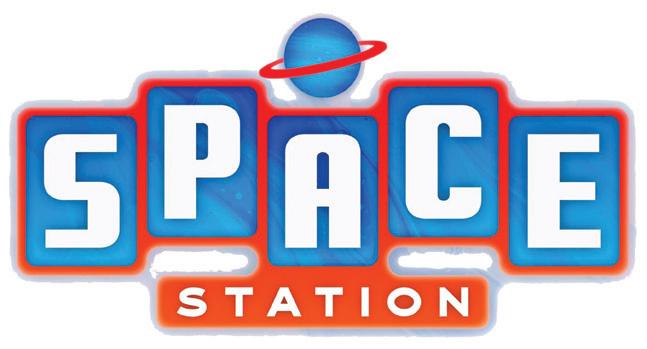
Lyons Restaurant
Mexican Restaurant
New Restaurant
Niwot Restaurant

Overall Restaurant

Pancake/Waffle
Pizza
Veggie Burger
Wings
DRINKS
Bar
Beer selection
Cidery
Cocktails
Coffee House
Coffee Roaster
Craft Brewery
Distillery
Happy Hour
Latte/Mocha
Margarita
Teahouse
Wine Selection
CANNABIS
Bargains at a dispensary
Carpet/Flooring




Electrician
Florist
Furniture Store
Heating, Venting, and Air Conditioning
Home Builder/Contractor



Home Finishing
Home Improvement
Hydroponic Store
Kitchen Supply Store
Landscaper
Mattress Store
Nursery/Garden Center
Painter
Pest Control
Plumber
Roofing Contractor

















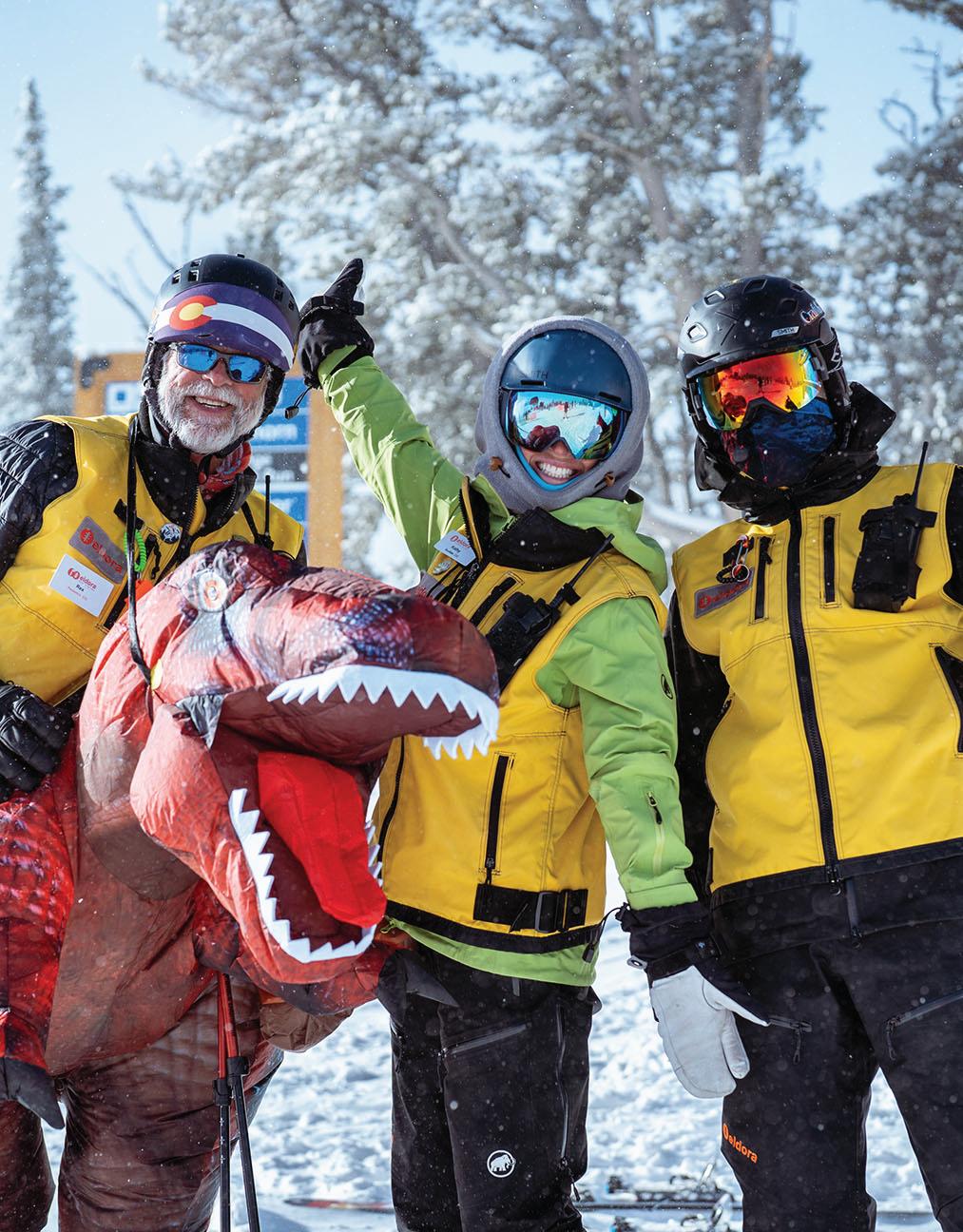



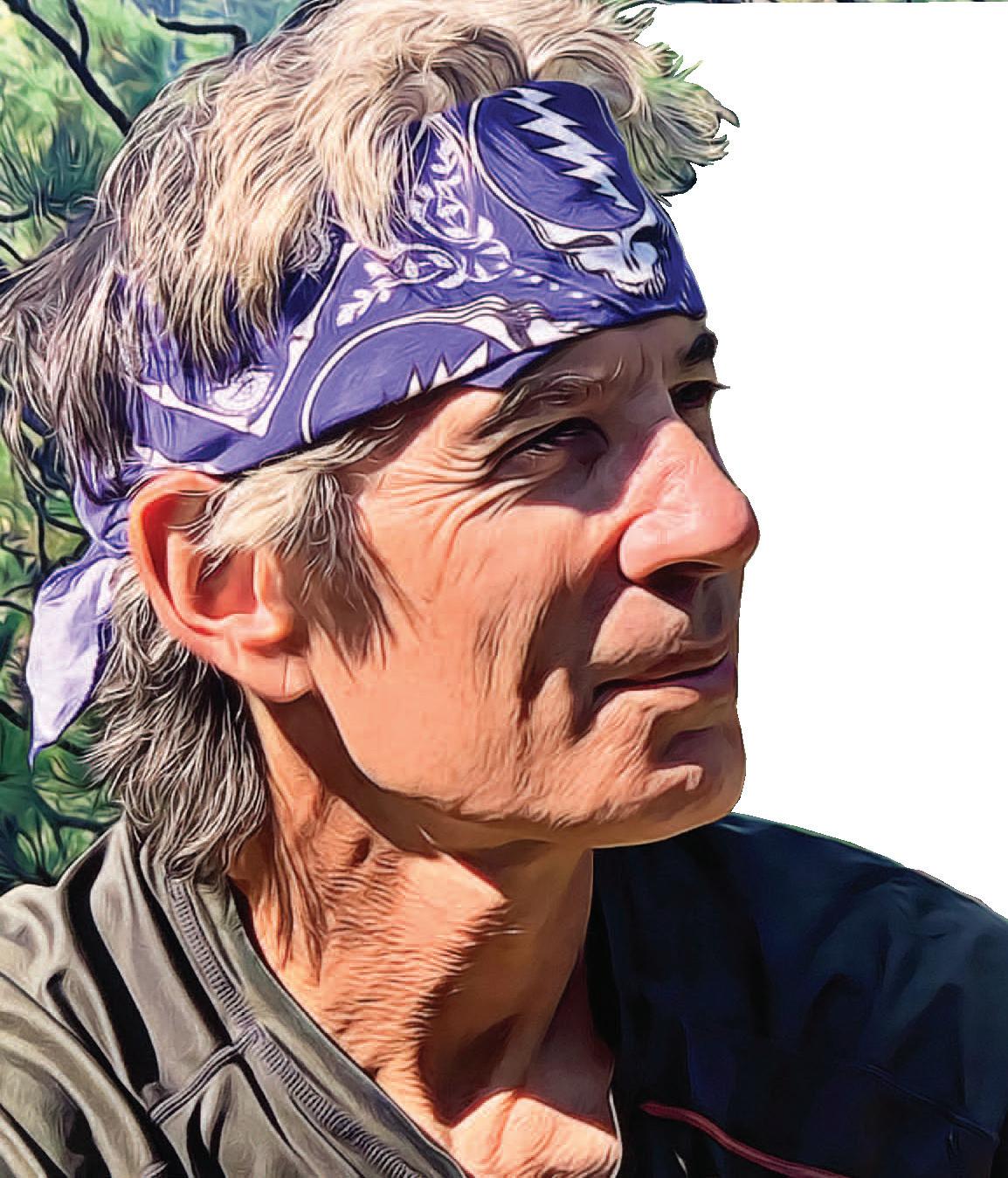

AUGUST 24, 2023
Volume 31, Number 1
PUBLISHER: Fran Zankowski
EDITORIAL
EDITOR-IN-CHIEF: Caitlin Rockett
ARTS & CULTURE EDITOR: Jezy J. Gray
GENERAL ASSIGNMENT REPORTERS:
Kaylee Harter, Will Matuska
FOOD EDITOR: John Lehndorff
CONTRIBUTING WRITERS:
Will Brendza, Rob Brezsny, Michael J. Casey, Dan Savage, Bart Schaneman, Toni Tresca, Colin Wrenn

SALES AND MARKETING
MARKET DEVELOPMENT MANAGER:
Kellie Robinson
SENIOR ACCOUNT EXECUTIVE:
Matthew Fischer
ACCOUNT EXECUTIVE: Chris Allred
SPECIAL PROJECTS MANAGER:
Carter Ferryman
MRS. BOULDER WEEKLY: Mari Nevar
PRODUCTION
CREATIVE DIRECTOR: Erik Wogen
SENIOR GRAPHIC DESIGNER:
Mark Goodman
CIRCULATION MANAGER: Cal Winn
CIRCULATION TEAM:
Sue Butcher, Ken Rott, Chris Bauer
BUSINESS OFFICE
BOOKKEEPER: Emily Weinberg
FOUNDER/CEO: Stewart Sallo
As Boulder County’s only independently owned newspaper, Boulder Weekly is dedicated to illuminating truth, advancing justice and protecting the First Amendment through ethical, no-holdsbarred journalism and thought-provoking opinion writing. Free every Thursday since 1993, the Weekly also offers the county’s most comprehensive arts and entertainment coverage. Read the print version, or visit boulderweekly. com. Boulder Weekly does not accept unsolicited editorial submissions. If you’re interested in writing for the paper, please send queries to: editorial@boulderweekly.com. Any materials sent to Boulder Weekly become the property of the newspaper.
690 South Lashley Lane, Boulder, CO 80305 Phone: 303.494.5511, FAX: 303.494.2585 editorial@boulderweekly.com www.boulderweekly.com
Boulder Weekly is published every Thursday. No portion may be reproduced in any form without written permission from the publisher. © 2023 Boulder Weekly, Inc., all rights reserved.
Boulder Weekly welcomes your correspondence via email (letters@boulderweekly. com). Preference will be given to short letters (under 300 words) that deal with recent stories or local issues, and letters may be edited for style, length and libel. Letters should include your name, address and telephone number for verification. We do not publish anonymous letters or those signed with pseudonyms. Letters become the property of Boulder Weekly and will be published on our website.
At any given moment during this smoky summer of 2023, hundreds of wildfires were blazing in the United States — more than 850 as of late July, according to the nonprofit Fire, Weather & Avalanche Center. Most of those wildfires ignited in the forests of the American West.
Fires were also burning by the thousands in Canada, creating a pall of particulate-dense smoke that blotted out views of the Chicago skyline and the Washington Mall. Those fires are expected to burn well into fall.
This hellish aspect lends weight to historian Stephen Pyne’s conclusion that we live now in an age of fire called the “Pyrocene.”
Assembled to combat these blazes is a massive army of wildland firefighters. Some are volunteers, some are prison work crews earning time credited against their sentences. Some are municipal firefighters dispatched to the woods.
Some 11,300 of them are federal firefighters, called “forestry technicians,” who work under the aegis of the Department of Agriculture and the Department of the Interior.
For all of them, it’s exhausting work. Wildland firefighters typically log 16-hour days for weeks at a time, burning 4,000 to 6,000 calories a day while carrying heavy backpacks.
It’s punishing labor and always dangerous. Barely a year has gone by in the last quarter-century that has not seen at least 15 firefighter deaths, the victims not
just of flames and smoke but also of heat exhaustion, vehicle accidents, air crashes, falling trees and heart attacks.
Often, they don’t die alone. In June 2013, 19 “Hotshots” burned to death in a horrific Arizona wildfire, the third-greatest loss of wildland firefighters in U.S. history.
Yet despite the hardships and the history, a mandated pay raise in June 2021, spurred by President Joe Biden, brought the minimum wage for federal wildland firefighters up to a mere $15 an hour.
Firefighters of my acquaintance seldom cite money as a motivator for their work. They fight fires in the spirit of public service, while in some rural communities, as a young Apache firefighter told me, “It gives us something to do.”
But firefighters, like everyone else, must shoulder rents and mortgages and






This summer as part of the City of Boulder’s “Social Streets” initiative, the Downtown Boulder Partnership is hosting a series of FREE fun events / activities along 13th Street between Arapahoe Avenue and Canyon Boulevard. (There is no cost to attend the events and all members of the community and visitors near and far are invited to attend to participate or just enjoy as spectators!) So grab your family/neighbors/friends and come meet on the street to celebrate community and enjoy our vibrant downtown district!
Please visit the website for specific event times and additional details!
JULY 21 DANCING IN THE STREET
groceries, and a paycheck of less than $3,000 a month just doesn’t cut it.

Enter a temporary order from President Biden raising that base pay rate by 50 percent. Put in place in August 2022, and retroactive to the previous October as part of a hotly contested package of infrastructurefunding policies, the pay raise was funded only until September 30, 2023, after which pay for wildland firefighters drops back to 2020 levels.
JULY 30 PICNIC ON THE PAVEMENT
AUGUST 4 YAPPY HOUR
Wildland firefighters lobbied for Biden’s pay raise to be made permanent but they made few inroads. That was until they finally found an ally in Arizona’s Sen. Kyrsten Sinema. Now an independent, Sinema allied with Republican Sens. John Barrasso of Wyoming and Steve Daines of Montana, and Democratic Sens. Joe Manchin of West Virginia and Jon Tester of Montana to introduce the bipartisan Wildland Firefighter Paycheck Protection Act. It would fund permanent pay increases.
AUGUST 13
BOULDER STREET SOCCER CLASSIC
AUGUST 25
MELANIN FUNK FEST
By late June of 2023, their bill had passed out of committee by a vote of 10 to 1, the only no vote coming from Republican Sen. Rand Paul of Kentucky. When it reaches the Senate floor, it will be open to debate and a full vote.
There, however, the politicians are likely to squabble, especially on the House side. Larger issues loom, too,
such as the need to revise policy so that forests are better managed to improve the conditions that now foster massive wildfires. Those conditions are the product of a “wise use” regime that saw forests as profitable tree farms and not as living systems The Forest Service also had a decadeslong policy of dousing all wildfires as early as possible.
While Washington deliberates, and while a more comprehensive bill compensating wildland firefighters struggles to gain traction, fires continue to burn in the outback. Without a pay raise, federal officials fear, some firefighters will walk away from a risky and insultingly low-paying job.
Wildland firefighters are needed right now, and we need to pay them what they deserve through the Wildland Firefighter Paycheck Protection Act. They will be needed even more in a future of climbing temperatures and widespread drought causing even more massive wildfires.
We can only hope that we will have the firefighters to confront them.
Gregory McNamee is a contributor to Writers on the Range, an independent nonprofit dedicated to spurring lively conversation about the West. He is an author and journalist in Tucson.
This opinion does not necessarily reflect the views of Boulder Weekly.
SEPTEMBER 8
CU ATHLETICS MEET & GREET
SEPTEMBER 24
COMMUNITY ART DAY
Part of the City of Boulder’s “Social Streets” initiative.
BoulderSocialStreets.com
Kudos to the Boulder City Council for voting to advance an initiative for this fall’s ballot extending an existing sales tax with an allocation of half of the revenue gathered from this tax to bring much needed funding to arts and heritage organizations without raising taxes.
Contrary to some opinions I’ve read, passing this initiative will not cut funding for existing services in Boulder. Rather, this funding will do two important things:
1) It will begin to close the gap between Boulder and comparable cities when it comes to funding arts and culture. Boulder currently spends 60% less on the arts than comparable cities ($17 per capita vs $43); and
2) It will provide much needed funding to artists and organizations who generate a positive return on investment for city coffers. According to the Arts & Economic Prosperity 6 Study, the nonprofit arts and culture industry generates $69.8 million in annual economic activity in Boulder, supporting 1,832 full-time equivalent jobs, and generating $4.6 million in local and state government revenues. Not bad for about $1.8 in current funding from the City of Boulder. This increased funding will also allow arts organizations to continue providing programming for public schools at little to no cost. For example, the organization I run, Parlando School of Musical Arts, provides outreach for tens of thousands of people every year. This includes providing 3,000 public school music classes with free onsite support. Our colleagues in BVSD have come to rely on this support to make their music programs happen. Some of these colleagues are teaching in three to five different schools every week. They need our help.

Boulder faces many challenges. Investing in arts organizations to help address some of these challenges leverages additional resources at a relatively small cost. That sounds smART to me.
— Travis V. LaBerge, executive director and founder of Parlando School of Musical Arts

I wonder how many of us realize that Donald Trump was able to enter the West Wing because of an outdated Electoral College system that should have 676 electors, not 538, per the “Wyoming Rule” proposal.
538 was fine in 1929, when Congress froze the number of seats in the House at 435. Today, we have under-represented people everywhere. The most notable problem with the 435 limit is California. Between the 2010 and 2020 census, the state saw a population increase of one million people, yet the state lost one congressional seat (and one elector) because of a 1929 law (The Permanent Apportionment Act). The number of seats in the House (and electors in the Electoral College) should be revised with every census taken.
— Pete Simon/Arvada
Given our recent abundance of warmth, water, and carbon dioxide, greenery in Boulder is having a banner summer. Emerald ash borers did finally kill a neighbor’s tree, but during the attack, it scattered thousands of seeds, and I have saplings, one 10 feet tall, popping up everywhere in my yard. Also, my golden rain tree is attempting to create a rain tree forest which, with the spread of chokecherries, mahonia, tansy, dock, burdock, cornflowers, et al of the wild world of weeds, has turned my backyard into an aspiring jungle, all without city water. The drought has eased, at least for now, and we have been spared the increasingly frequent climate disasters occurring around the world. We should thank our lucky stars, but must never forget that global warming and climate change will be with us into a yet undetermined offing.
— Robert Porath / BoulderSee a mistake? Have something to say? We encourage readers to contact us: letters@boulderweekly.com


 BY KAYLEE HARTER
BY KAYLEE HARTER
Boulder’s first rank-choice voting mayoral election is approaching and candidates began filing their paperwork to run earlier this month.
Running for mayor are council members Nicole Speer and Bob Yates, and sitting mayor Aaron Brockett.
Until now, Boulder’s mayor was appointed by City Council members. In the rank-choice voting system, a candidate who garners more than half of the first-choice votes wins. If no candidate receives more than 50%, the candidate with the fewest first-choice votes is eliminated, and the second-choice votes on those ballots will be counted. That process continues until a candidate has more than half the votes.
Any additional candidates must submit their bid for mayor by Aug. 28, which requires candidates to have 25 to 35 registered electors sign their petition.

Candidates running for the other four open seats on City Council are current council member Tara Winer, Taishya Adams, Jennifer Robins, Waylon Lewis, Jacques Decalo, Terri Brncic, Tina Marquis, Ryan Shuchard and Silas Atkins.
Boulder County Chamber will hold a City Council Candidate Forum Aug. 29 from 5-8 p.m. PLAN-Boulder County will also hold a public discussion Aug. 29 at noon in the Boulder Public Library.

Boulder City Council voted 6-3 to raise the occupancy limit to allow five unrelated people to live together, a move supporters say will increase access to affordable housing.
The previous ordinance allowed three unrelated people to live together in low-density zoning districts and
four in high-density zones. There are no limits on family members.
Mayor Aaron Brockett, who voted in approval at the Aug. 17 City Council meeting, said the move was a step toward affordability and accessibility in Boulder “without building anything, without tearing anything down.”

The vote followed more than four hours of public comment.
Supporters of increasing the occupancy limit pointed to inclusivity, affordable housing, environmental sustainability and the benefits of communal living. Opponents voiced concern about parking, nuisance complaints and whether the ordinance would actually make housing more affordable.
“This is a small step for housing and for personal freedom and accountability, but it feels like a giant leap forward for inclusion and for community,” said council member Nicole Speer, who voted in favor of the change but said there was still work to be done in terms of “helping people stay in our community and slowing these housing [price] increases.”
Council member Bob Yates, who opposed the ordinance, called it a “missed opportunity to guarantee affordable housing.”
“I think we’re deceiving ourselves and our community if we think this law will magically make Boulder more affordable. It will not,” he said.
Some, such as council member Mark Wallach, also took issue with City Council rather than voters approving the occupancy limit, citing the 2021 Bedrooms Are For People ballot measure that would have raised the occupancy limit to the number of bedrooms in a unit plus one, which lost by a vote of about 52% to 48%.
“They were not voting against a formula calculating density. They

were voting against the increase itself,” Wallach said. “You don’t have to like the result, but that was the community’s decision.”
Other council members pushed back on that assertion.

“This was a unanimous 9-0 vote to add this to our work plan,” council member Rachel Friend said. “This is a democratic process; we are a representative form of government. We are not voting on the same thing that was rejected.”

Boulder County Commissioners voted 2-1 to end a 41-year-old conservation easement on the edge of Longmont — answering one of the county’s many debates on affordability, housing, open space and conservation.
The termination allows for the 38-acre plot on the east side of Airport Road to be annexed into Longmont, and makes room for the construction of up to 426 “affordable” and “attainable” units in a development named Somerset Village. Commissioners also added conditions to compel the developer to commit to providing lower-cost housing in the development.
A conservation easement is a voluntary agreement between a landowner and another entity, such as a land trust or government agency, that restricts use on a parcel of land. The Kanemoto Estates easement was established in 1982 between the Kanemoto family who owned the property and Boulder County Parks and Open Space, but like more than 130 others across the county, the arrangement included language that allows for ending the easement to make way for development.
The review process was initiated by the landowner and developer Lefthand Ranch LLC, requesting to terminate the easement, annex the land into Longmont and develop a residential neighborhood.
Commissioners Clair Levy and Marta Loachamin voted in favor of the termination. Ashley Stolzmann was opposed.
Two Boulder-based runners dominated the Leadville 100 ultramarathon, which celebrated its 40th anniversary this year.
Some 700 runners from 49 states and 30 countries started the 100-mile race across 15,000 feet of net elevation gain on Aug. 19. Only 44% of them finished.
Jacquie Mannhard, who finished first in the women’s race, finished with a time of 21:24:55 — more than an hour and 45 minutes faster than the next fastest runner. JP Giblin, who finished first in the men’s race, finished with a time of 17:07:25.
Free bus rides on a fixed route between Ward and Rollinsville have relaunched to help connect residents to essential services along the Peak to Peak Highway.
The service, Mountain Rides, is intended to address transportation gaps for residents and stops at various human services, recreation and shopping sites including a food bank, trailhead and library.
Mountain Rides runs on Wednesday and Thursdays from 10:30 a.m. to 3:45 p.m. No reservations or passes are required. The service connects to RTD northbound route between Nederland and Boulder at the downtown Nederland RTD Park-n-Ride.
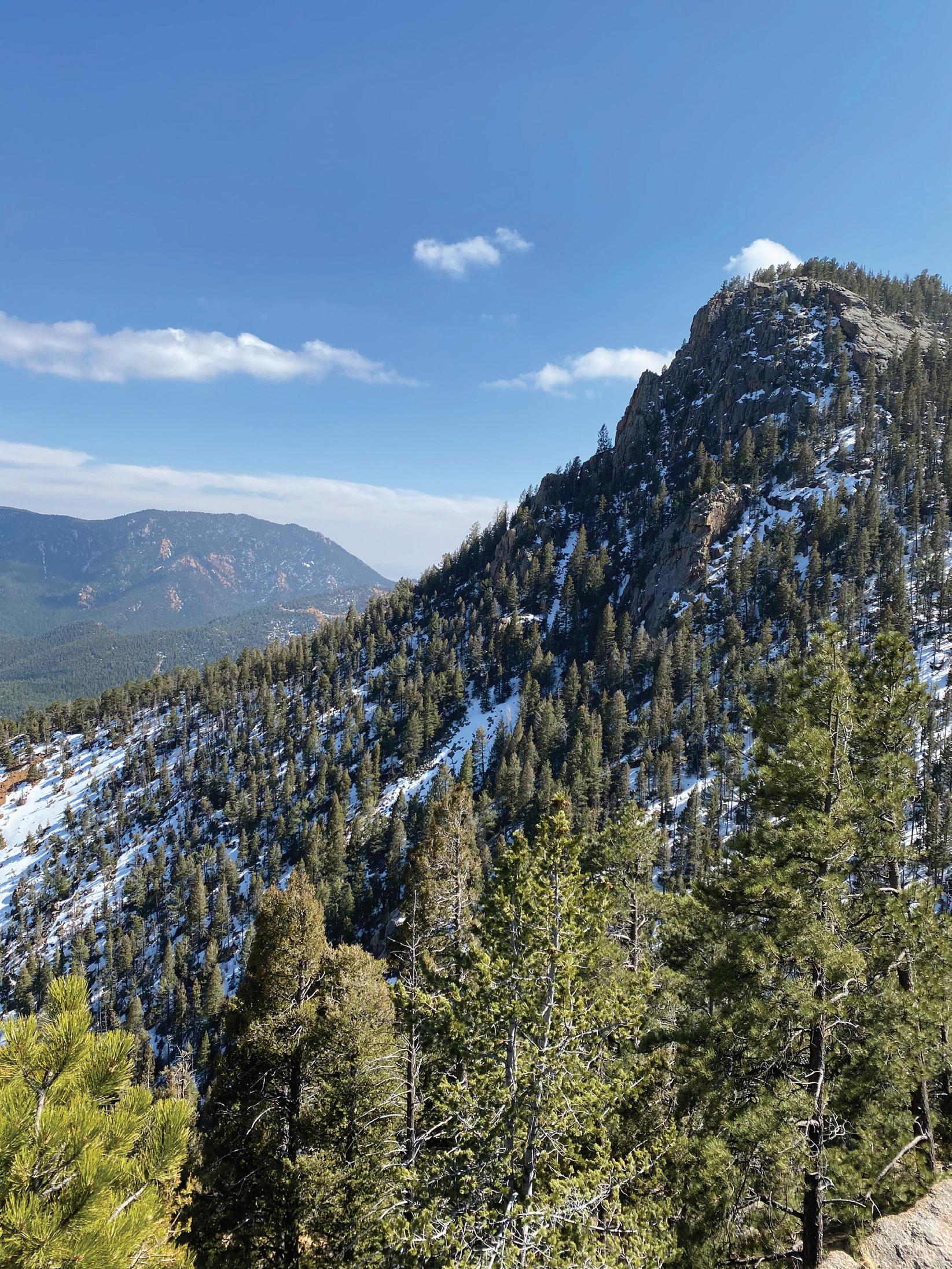


Boulder County residents now have access to free chipping services as part of an effort to reduce wildfire risk.
The County-supported program aims to foster “a safer, cleaner, and more fire-resilient environment for all” through helping residents dispose of green branches and brush.
The county has had a chipping program in place since 1993, but the new program increases the services provided, according to an Aug. 16 press release.
To be eligible, one household must host “community chipping events” for at least five properties. More information on the application and scheduling process can be found at bit.ly/ BoulderChippingProgram

It was just before dawn, and they were moving quickly.
A headlamp-guided group of activists, who call themselves water protectors, scurry in the middle of a rural dirt road to set up a temporary structure. Shadows linger at the edge of the surrounding dense northern Minnesotan forest.
The bamboo-like construction is made of three sections of beams crossed and stacked on top of each other, rising about 35 feet. A makeshift ladder hangs in the middle as a portal to the two hammocks nested at its crown.
That’s where Boulder resident Mylene Vialard found herself near the end of August 2021, protesting the upgrade and expansion of Line 3, a pipeline that transports oil from Edmonton, Alberta, and across Minnesota to Lake Superior. Along with putting water bodies at risk and exacerbating climate change, water protectors like Vialard argue the new pipeline would threaten nearby Indigenous communities and their rights to hunt, fish and gather wild rice.
Underneath a royal blue hard hat, Vialard’s nose and mouth are covered by a black mask with white print: INJUSTICE.

“I’m here for my daughter and my daughter’s daughter and all their children and grandchildren,” Vialard said in a video from the event. “I’m here because there’s a real climate crisis and nobody seems to care. I’m here because that’s the only thing I can do right now. I have to show up and I have to defend this land and the rights of the people who have been on this land forever.”
She was arrested that day while bystanders cried for officers to stop as they forcefully removed Vialard and her collaborator from the top of the structure.
Despite years of public resistance to Line 3, it was completed later that fall.
Two years later, Vialard is returning to Aitkin County on Aug. 28 to face the felony charge of obstructing the legal process. If she’s found guilty, she could face up to five years in prison and a $10,000 fine.
The term “water protector” is a concept in activism that arose in 2016 from Indigenous communities during the Dakota Access Pipeline protests at Standing Rock Reservation in North Dakota. These advocates are defined by a philosophical approach rooted in Indigenous perspectives that see water and land as sacred. Many white protestors, like Vialard, take on the mantle to show solidarity with Native communities.
Experts around the country are recording a steady increase of worry about climate change, coined as climate anxiety. Sometimes it results in direct action, like at Line 3. Other times it doesn’t. But Sara Jaquette Ray, a professor of environmental studies at Cal Poly Humboldt, says it’s an “overwhelmingly white” phenomenon.
“The prospect of an unlivable future has always shaped the emotional terrain for Black and brown people, whether that terrain is racism or climate change,” Ray wrote in her 2020 book, A Field Guide to Climate Anxiety “Exhaustion, anger, hope — the effects of oppression and resistance are not unique to this climate moment. What is unique is that people who had been insulated from oppression are now waking up to the prospect of their own unlivable future.”
Defining the role of people “waking up” to the climate crisis is critical for the movement to continue moving forward.
“There already is a mental health crisis, once we come to terms with the eventuality and the severity of climate
impact,” says Renée Millard-Chacon, executive director of the environmental nonprofit Womxn from the Mountain. “People are going to panic, they are going to feel apathetic. … So justice is not just a priority, but it’s legitimately what’s going to maintain our foundations of a society to get through that.”
Racism and environmental injustice are inextricably linked.
It’s been documented countless times across the country: Black and brown communities, low-income neighborhoods and other areas where people have limited power and resources are chosen for the sites of industrialized facilities like power plants or highways that negatively impact the health and wellbeing of the people living there.
It’s not a coincidence, for example, that Suncor’s oil and gas refinery in Commerce City is surrounded by majority Latino and low-income neighborhoods who are, as a result, exposed to higher than average pollution levels.
Environmental justice is also about protecting the places we live, work and play, which is why organizations like the Sierra Club are fiercely advocating against the Uintah Basin Railroad project that would allow crude oil to be carried from Utah along more than 200 miles of the Colorado River to refineries on the Gulf Coast.
A federal appeals court rejected an essential permit for the project on Aug. 18. Although the railway is delayed, the U.S. Surface Transportation Board is expected to continue pursuing the project.
While people who have historically been victims of pollution and climate
externalities still bear the brunt, now those impacts are being felt across communities nationwide more than ever before with widespread wildfires, irregular storm patterns and heat waves.
Ray says climate solutions that don’t take into account the history of racism and oppression replicate the same systems that cause social injustice.
“Climate change is just exposing everyone to the fact that the system has never benefited anyone, and now the entire ecosystem on which all human life depends is under threat.”
Vialard says some of her biggest takeaways from her activism at Line 3 are about navigating her role as a white woman and acknowledging her privilege and bias through decolonization training.
But it can be a tricky line to walk — when white participation is harmful or productive — in a movement that dismantles oppression white folks caused and benefit from, and empowers people disproportionately impacted by climate change.
At one point in northern Minnesota, Vialard was called out by a person of color for doing something she had “no clue was harmful, but it was.” She says she learned a valuable lesson on the difference between intent and impact.
“It’s about white supremacy, what it represents and what has been done by people who look like me,” she says. “So being conscious of my body in that way and what I represent was the greatest lesson.”
While acknowledging that white people have a role in maintaining a system of oppression and have a responsibility to act, Vialard says support needs to be fluid and based on listening.
Sometimes it’s “essential” for white people to step in, Ray says, like when privilege can be deployed by a white person or if there’s a financial cost at stake, but should be utilized at the right moments.
“There are times when there’s the white savior complex at play, and the sort of hero thing that is damaging and silencing,” she says. “And that line is a difficult one to draw and different people might say that line is different.”
“It’s very tricky and I think most white people say, ‘That’s too hard. I don’t know how to navigate that.’”


Millard-Chacon, whose background includes Diné, Xicana and Filipina heritage, says allies should avoid centering their own narrative and give BIPOC and Indigenous voices space in decision-making processes.
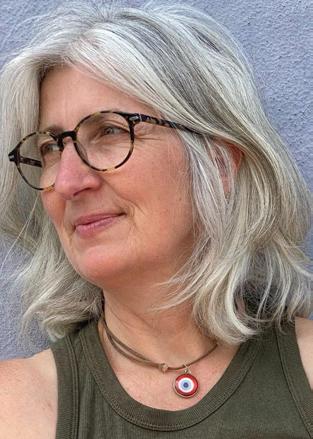
“These communities are doing more [with less] to even protect their communities,” she says. “So when we’re asking for allies in those spaces, or when we’re showing that we need accomplices, what it’s really going to take is for communities to understand that it’s now time to relinquish privileges.”
But for some it’s not natural to participate in a movement that completely reimagines the systems that white people have benefitted from, and either may not be keen to let them go or can’t imagine a different world.
“There’s a request [in the climate justice movement] to completely throw out everything from Western colonial mindsets and re-engage with the world in a completely new way,” says Ray. “That is really scary to a lot of people and that’s one way white fragility manifests in the inability of white people to participate in climate change [activism].”
As a mother, Millard-Chacon says she has no choice but to be an optimist.
“I always tell my kids not to lose heart. I know it’s scary, and you were born in pollution you don’t deserve. But so was I,” she says. “There is an ability to have joy. You do deserve to have a creative and expressive life without extraction and exploitation. And it’s overdue for all of us to look at ourselves without environmental and colonized paradigms.”
Vialard has spent most of her life studying racial and environmental justice. On her way up the structure on the day she was arrested, she says she felt she was a part of a movement and a community.
“We are trained to think that we
have to do it all by ourselves, that we have to be looking at ourselves and taking care of ourselves only. And it’s the wrong way to be,” she says. “If we want to be happy, if we want to have rich lives, we have to create community, and a community of values, but also communities with people we’re not currently in community with. We really have to experience each other. And that’s been one of my greatest lessons from Line 3.”
Since the summer of 2021, it was revealed that more than $8 million in additional resources was reimbursed to law enforcement by an Enbridge-funded escrow account to handle opposition to Line 3. The Aitkin County Sheriff’s Office, which arrested Vialard, was reimbursed more than $300,000.

Claire Glenn, a staff attorney for the Climate Defense Project representing Vialard, has represented nearly 100 Line 3 activists. She says most cases have resulted in dismissals due to overcharging.
“The criminal system did not end up going after people to seek criminal charges … and that’s because this wasn’t about public safety, it was about getting a pipe in the ground as quickly as possible,” she says.
Line 3 has leaked four times since the pipeline was completed — exactly what Indigenous leaders and other water protectors argued would happen.
“We’re starting to understand that [Indigenous people] are right, they’ve been right all along,” says Vialard. “And we’re still not listening. We’re still violating the rights, we’re still putting profit over people.”
Vialard didn’t take the plea deal offered to her, saying she couldn’t come to terms with stating she was guilty.
“Enbridge Corporation is the one destroying the land, is the one destroying the traditional way of life of Indigenous people, is the one altering the ecology and the environment, is the one denying the right to ceremony to the Indigenous people,” says Vialard. “All I did was say, ‘No.’”

Niwot Roofing




s a small, local business formed here in small town Niwot in 2022 with high values. Free Class 4 shingle upgrade is just the start, we will help customize your home from the color of your shingles down to the flashing of your drip edge. Our roofing crew of 37 have been serving Colorado sense 2002 and our team of project managers are knowledgeable in all shingle manufacturers, not just Owens Corning or GAF. Our attention to detail and customer service, Niwot Roofing is striving to care for our community. The owner, Michael Overfield was born and raised in Boulder and resides inNiwot donating back to the Niwot community with every roof in Niwot. “I take pride in my work and where I’m from, there is no better place to live than in Boulder County”. We work through insurance as well, it can be a tough process but we make it easy with a team of supplementers and project managers. From a simple repair to a full roof replacement, give us a call for a free inspection and consultation.
Niwot Roofing info@niwot-roofing.com 303.709.5984




baked


www.longmontbakery.com



Locally woman-owned and operated, Wild Birds Unlimited Specializes in bringing people and nature together through the hobby of backyard bird feeding. We offer a wide variety of naturerelated products and expert, local advice. Our store stocks the highest quality items made in the the USA with emphasis on eco-






friendly products and recycled plastics. We source our unique gifts from Fair Trade companies and local artisans. We also have gift cards and last-minute gift ideas. Stop in and let us explain our mission to Save the Songbirds one backyard at a time!

1520 S. Hover Street, Suite D Longmont, CO

720-680-0551
www.wbu.com/longmont


oZO Coffee Company is a coffee roaster & retail operator based in Boulder, Colorado with Espresso Cafe locations in Boulder and Longmont, Colorado.


Founded in 2007, OZO Coffee has based its growth on core
At Brown’s, we know feet. Our expert staff will measure your feet to ensure a proper, comfortable fit. With a broad range of widths and sizes, we can serve even hard-to-fit customers. We also understand most common foot ailments, such as plantar fasciitis, neuropathy, bunions,
We are crazy for clean cars!! We are a locallyowned and operated express tunnel car wash located at 1876 Hover Street in Longmont. Our state-of-the-art carwash system reclaims 70% of the water used, because we

My name is Rachel Shannon, the owner of Dee-O-Gee in Longmont. I am originally from Montana and moved to Longmont in 2004. I was always very attracted to the local shops because I was raised in a Ma and Pa Grocery store and fell in love with the local community. Starting Dee-O-Gee, which is a small start up from Montana, was a no-brainer for me.
principles of service, quality, community, and sustainability.

We are grateful for the opportunity to share our passion for coffee with you.
JUSTIN HARTMAN, OZO FOUNDER
1232-A S. Hover St. www.ozocoffee.com
diabetic feet, over pronation, and just plain tired feet! We’ll help you find the right shoes to make your feet happy.
373 Main Street, Longmont 303-776-2920

www.brownslongmont.com

care for your car and the environment. Our tunnel system uses a conveyor belt to avoid scratching your shiny rims. We also offer a mat washer system for those dirty floor mats. We would love the opportunity to help you get your car Washed Up! 1876 Hover Street, Longmont www.washedupcarwash.com 303-532-4365


We are growing organically here at Dee-O-Gee and our Google reviews are proof that we are doing our best to get that local vibe. Our shop is owned and operated by my family and me. We offer you a unique one on one experience when you come in the door. We are certified pet nutritionists and we will help you find the perfect diet for your pet. Our services include grooming, day camp and do it yourself dog wash.




110 Emery Street, #A, Longmont, CO 970-629-6600 • www.longmont.dee-o-gee.com

Denver author Erika Krouse recently won the 2023 Colorado Book Award for creative non-fiction with her memoir Tell Me Everything, an account of her time as a private investigator working a sexual assault case involving football players at an unnamed Colorado university. But it doesn’t take much in the way of detective skills to figure out that she’s writing about an institution in our own backyard: CU-Boulder.

For legal reasons, she never specifically says it in the book, but the case Krouse worked on was the 2007 Title IX lawsuit filed after allegations of rape at a party attended by CU football players in 2001. In that case, the university reached a settlement with one woman for $2.5 million and another for $350,000.
Taken separately, the elements of the book have all the makings for a sensationalized account — sexual violence, systemic abuse, athletes living above the law, and the slow-grinding wheels of the justice system. But this isn’t that kind of book. It’s bigger than that.
That’s largely due to Krouse’s ability as a writer. She’s published fiction in The New Yorker and works as a creative writing professor at Regis University and Lighthouse Writers Workshop in Denver. She expertly weaves the disturbing material of the P.I. case with the story of her own personal battles to create a compelling narrative that’s more than just an accounting of terrible abuses. Krouse worked hard to not only avoid exaggerating the facts, but to protect the identities of the very real people she depicts.
“That’s the thing that kept me up at night,” she says. “I was scared of hurting people. I would either have insomnia or wake up in the middle of the night and say, ‘Oh my god, I forgot to change the state that person is from.’
These are people I worked to protect. And they really wanted to tell us their stories. It’s important to protect them.”
One of the more impressive accomplishments in Krouse’s tale is the way she builds a cohesive, dramatic arc out of both stories — the case and her personal life — that comes together with a satisfying climax and resolution.
“I don’t have a lot of periods of time in my life that really fit that kind of narrative arc, but this one just did,” she says. “There were places where, if it had been a novel, I would have been able to change what happened [and] move things around. But you can’t do that with nonfiction.”
This was Krouse’s first attempt at a memoir, and she ended up having to reckon with the advice she gave her students. She used to tell them that writing a memoir and fiction are the same: You’re telling a good story. And that may be true to a point, but she also learned that the two modes are very different.
For one, Krouse had to be painstakingly careful about the facts. If she screwed up one detail, she not only risked losing the reader’s faith in the story, but in the case itself.
“There are a lot of high stakes with regard to accuracy and journalism, and I’m not a trained journalist,” Krouse says. “It was an on-the-job training kind of situation.”
Then there’s the personal angle. Krouse unflinchingly delves into her relationships, including with her partner, her mother and her boss. There’s
also an unnamed abuser from her childhood that reappears throughout the story as she tries to convince family members of the trauma she suffered. This didn’t come easy. Krouse wasn’t used to mining her personal history for material.
“That was a strange thing for me,” she says. “I’m actually a pretty private person. That was a leap of faith I had to make toward the reader [so] they would be compassionate to me, too. It took a lot of long nights and I’d say a fair amount of alcohol to get through that.”
Publication of Tell Me Everything was shut down for seven months because of what Krouse calls “legal bullying.” She says that taught her the importance of finding a pro bono lawyer to help back her up. Krouse declined to comment further on why the book was stalled, citing legal reasons.

Early in the book, Krouse writes about how she has a face that makes people want to tell her things. That quality helped her as a private investigator in this case, but the author also credits her success in the field to an awareness that people simply want someone to care about their lives.
“Most people want to be seen,” she says. “Most people want to be known for who they are, even if it’s scary.
That’s why a lot of extremely brave women came forward and talked about what happened to them, even at greater cost to themselves.”
After the 2007 Title IX case ended, a string of similar allegations began to surface at universities across the country. Krouse says more sunlight on a “rampantly abusive” system has expanded the frame for thinking about such cases altogether.
“It began not just a new way of looking at law, but also a way of looking at sexual abuse,” she says. “[It’s] not just a criminal problem, but also a systemic problem and a civil rights issue.”
Today, Krouse has largely set aside private investigation work. She might do a favor for a friend with a stalker as a one-off, for example, but she’s mainly focused on writing and teaching. Her next book, a collection of short stories, is due sometime next year.
“That’s not to say I wouldn’t take a case if it were amazing,” she says. “If it were something I could really sink my teeth into. I haven’t had any cases like that in a while. But if one of those dropped in my lap, I would do it.”
ON THE PAGE:
Everything: The Story of a Private Investigation by Erika
 BY TONI TRESCA
BY TONI TRESCA
When a good theatrical production does its job, the audience is moved on a cellular level by the essence of human creativity. Actors embody the soul-stirring narrative of the playwright, turning our deepest fears, hopes and joys over in the spotlight. But it’s what happens in between these two points that the Front Range Playwrights’ Showcase, a night of staged readings hosted by Coal Creek Theater of Louisville (CCT), is designed to celebrate.
“I have a lot of friends who are nontheater people, and one of the ways I’m promoting this event to them is by explaining that this is how the sausage gets made,” says Brett Nickerson, director of Earworms for this year’s showcase. “You don’t write a two-hour play and it just gets produced; you start with a draft and a reading to work out the kinks.”
Originating in 2007 as an evening of lightly produced one-act plays, the festival has evolved over the years into two distinct endeavors: The Front Range Playwrights’ Showcase and An Evening of Colorado-Grown One Acts.
“When we first started, we thought we could do a little bit of blocking and costuming,” says CCT board secretary Lynn Fleming. “But we quickly turned it into a straight-stage reading.”
CCT received 21 scripts between March and May, all meeting the nonprofit’s hour-or-less length requirement and falling under one important rubric: All plays must be penned by a Colorado resident. But when it comes to the topics of the winning works themselves, all bets are off.
“There’s a slight similarity to all three plays because they are all very futureoriented,” says CCT artistic director Kirsten Jorgensen Smith. “But I love that we were able to find three stories that really aren’t 100% alike at all.”
The 2023 Showcase includes the aforementioned Earworms by Brad Rutledge, Plugged In by Grant Swenson, and Serving the Story by Scott Gibson. These plays will be performed in Reader’s Theater style, with adjudications by Alphonse Keasley, Madge Montgomery and Terence Keane.
“Our special play election committee has been reading them as they’ve been coming in and scoring them individually, not against each other but on their own merit,” Smith says. “We then chose our top three and matched them with directors by July 1, so we can start rehearsals for the showcase in August. Additionally, after our showcase this year, audiences will be able to return to see these plays fully produced in August 2024.”
Earworms, written by Rutledge and directed by Nickerson, follows two men who meet after the funeral of their college roommate. Although he has performed with CCT and written several plays that have been produced locally, this is Rutledge’s first submission to the showcase.
“After I talked to Steve Rausch, who is one of the board members, he encouraged me to take a chance and submit a script,” Rutledge recalls.
“While trying to figure out what to write about, I saw a play featuring a local actor named Wade Livingston and decided to write something for him to perform.”
Plugged In, written by Swenson and directed by Jeremy Denning, takes place in a completely different part of the galaxy. The narrative invites readers to travel to a planet with a special form of evolution.
“Back in 2013, I joined a local playwriting group in Colorado Springs called Drama Lab and heard through that group that CCT was looking for submissions,” Swenson says. “So, I found a science fiction play that I had written the previous year, and I submitted it. And I was chosen as one of the top three and won the showcase that year. Recently, I made the decision to write a sci-fi follow-up about this alien world where evolution differed from that on Earth.”
The final production of the showcase is Serving the Story, written by Gibson and directed by Smith, which follows actors who find themselves trapped in a play.
“I’ve submitted several times, and I’ve been fortunate enough that they have selected three of my plays over the years to be produced,” Gibson says. “They’ve always done lovely work with my plays, so applying is always a no-brainer. This year, I wanted to come up with something that was sort of absurdist and surreal. As the plot progresses, you realize the characters are
aware that a subpar playwright is forcing them to participate in activities ... for his own amusement; it is a little dark but also has some humor in it.”
And the showcase is more than just a platform for highlighting talent; it’s also a testament to the deep bonds formed between playwrights, actors, directors and the community at large.
“Playwriting is such a solitary, lonely process,” Gibson says. “When you first begin to write a play, you are sitting in a room by yourself, writing what works for you; putting a play in front of an audience who has no idea what the play is about leads to such invaluable feedback. I may write something that seems terribly funny to me, but when the actor says it, the line lands with a thud. When I hear that, I think, ‘OK, what I find humorous is not necessarily what an audience finds humorous,’ which is a very helpful realization for any writer and really improves the play.”
ON STAGE: Front Range Playwrights’ Showcase by Coal Creek Theater of Louisville. 7 p.m. Friday, Aug. 25, Louisville Center for the Arts, 801 Grant Ave. $10
EVERY WEDNESDAY BOULDER BLUEGRASS JAM
THU. 8/24 - 7:00PM
CLAY ROSE SINGER WITH PAULA GAYATRI DEVILLIER
FRI. 8/25 - 8:00PM
TERESA STORCH BAND WITH MACKENZIE RAE
SAT. 8/26 - 7:00PM
COLLAPSING STARTS AND DECHEN HAWK
TUE. 8/29 - 6:30PM
PAUL SODERMAN AND THE OGS WITH DFK AND THE LAB RATS
MON. 9/1 - 8:00PM
BACK STABBATH & HOWLIN’ GOATZ
THU. 9/7 - 7:00PM
TROUBANDOURS WITH RAMAYA SOSKIN FEATURING BETH PRESTON & HUNTER STONE
FRI. 9/8 - 8:00PM
ROCKET PARADE
SAT. 9/9 - 7:30PM
SETH GLIER
MON. 9/11 - 7:00PM
AMY LEVERE & WILL SEXTON
TUE 9/12 - 8:00PM
BLAIR BORAX, MEGAN BURTT & ALEX DUNN
THU. 9/14 - 8:00PM
ANTONIO LOPEZ BAND & LAURIE DAMERON
SAT. 9/16 - 6:00PM
K9’S, COWBOYS & COCKTAILS FUNDRAISER
TUE. 9/19 - 6:30PM
MOJOMAMMA LIVE BROADCAST ON 88.5 KGNU
Purchase Tickets at RMPtix.com
RootsMusicProject.org

4747 Pearl Suite V3A

25
POETRY NIGHT
BUGS AND BREWS
5-7 p.m. Thursday, Aug. 24, Butterfly Pavilion, 6252 W. 104th Ave., Westminster. $40
Are you a social butterfly? Head to Westminster for this after-hours 21+ event at the Butterfly Pavilion where nature, knowledge and libations collide. Tickets include two hours of adultonly exhibitions and a couple glasses of beer or wine to complete the experience.

STAINED GLASS GEEK
6:30-8 p.m. Friday, Aug. 25, Colorado Glass Works, 1500 Pearl St., Suite D, Boulder. $50
Want to learn about stained glass from one of the artform’s leading artists? Special guest instructor Arjan of Stained Glass Geek travels all the way from the Netherlands for this onenight lecture with insight design, business tips and more.
25

COLORADO NATIVE
7-8:30 p.m. Friday, Aug. 25, Grace Gamm Theater, Dairy Arts Center, 2590 Walnut St., Boulder. $15
MELANIN FUNK FESTIVAL
6-9 p.m. Friday, Aug. 25, 13th Street between Arapahoe and Canyon, Boulder. Free
Celebrate Black culture and community during Melanin Funk Festival, an evening of food, drinks and music in the heart of downtown Boulder.
Colorado hip-hop duo The Reminders headline this free event, so be sure to bring your dancing shoes.

“Natives are funny.” That’s the simple premise behind one of the country’s only Indigenous comedy showcases presented by Creative Nations space at the Dairy Arts Center on Aug. 25. Colorado Native features headliner Sienna East (Choctaw) and host Joshua Emerson (Navajo) for a night of “the best in Indigenous comedic talent from all over Turtle Island.”

7-9 p.m. Friday, Aug. 25, Firehouse Art Center, 667 4th Ave., Longmont. Free
August is the cruelest month at Firehouse Art Center, whose Fridaynight poetry event is a great way to connect with your community through the written word. Come celebrate everyday revelations through verse and meter during this monthly writers meetup in Longmont.

COURTYARD SUMMER CONCERT SERIES: MOJOMAMA
7-10 p.m. Friday, Aug. 25, Downtown Louisville, 836 Main St. Free
Need a little “funked-up blues” in your life? BoCo music mainstay Mojomama brings their time-honored sound to the Courtyard Summer Concert Series in Louisville on Aug. 25. For more on the band, check out their feature in the 2023 Longmont Insider included with this week’s issue.

VENUS DE MILES

6 a.m.-5 p.m. Saturday, Aug. 26, Bohn Park, 199 2nd Ave., Lyons. $125 late registration (through Aug. 25); $200 on event day
Ladies, to your bikes! Colorado’s “first and finest all-women’s bike ride” celebrates sisterhood on two wheels with a 30-mile ride culminating in the celebratory Finish Festival featuring food vendors, live music, wellness activities and more.

27
PLANET-BASED LIVING FESTIVAL
11 a.m.-5 p.m. Sunday, Aug. 27, Central Park Bandshell, 1212 Canyon Blvd., Boulder. Free

Sustainability takes center stage at this community celebration of the big blue marble we call home. From ecofriendly fashion to upcycled crafts and organic treats from local food trucks, the Planet-Based Living Festival is a great start on the path to a greener future.

SAVING SUMMER: PHOTO MEMORIES PROJECT
6-7:30 p.m. Tuesday, Aug. 29, Longmont Public Library, 409 4th Ave. Free
Longmont Public Library hosts a free photo project for middle and high schoolers looking to preserve their memories of the waning summer season. They’ll bring four-to-six of their favorite photos from summer (digital or print) and turn them into a collage that’ll last a lifetime.

26
BOULDER VINTAGE BICYCLE SWAP & SHOW
9 a.m.-3 p.m. Saturday, Aug. 26, The Riverside, 1724 Broadway, Boulder. Free

Ride down to The Riverside parking lot on the corner of Broadway and Arapahoe on Aug. 26 for the Boulder Vintage Bicycle Swap and Show. From heavyweights to townies, you’ll find all sorts of classic, vintage and antique bikes and parts — plus food vendors and a beer garden.
28
BOCO YOUNG DEMS LAUNCH PARTY
5-8 p.m. Monday, Aug. 28, Velvet Elk Lounge, 2037 13th St., Boulder. Free
Know a young progressive with a passion for electoral politics? They’ll want to get in on the ground floor of the Boulder County Young Democrats during the organization’s launch party at Velvet Elk Lounge on Aug. 28 — featuring “drinks, hot chicken and spicy politics.”
31

MUSHROOM FORAGING WORKSHOP
9 a.m.-noon. Thursday, Aug. 31, location TBD. $85
Zach Hedstrom, founder and owner of Boulder Mushroom, joins forces with BMoCA for a morning of hiking and fungus. Learn about foraging, mushroom ecology, habitat and identification — and sketch your favorite ’shrooms along the way.

THURSDAY,
CLAY ROSE WITH PAULA GAYATRI DEVILLIER. 7 p.m. Roots Music Project, 4747 Pearl, Suite V3A, Boulder. Free
DR. JIM’S ONE MAN BAND
5 p.m. BOCO Cider, 1501 Lee Hill Drive, Unit 14, Boulder. Free
SULLIVAN KING WITH KLIPTIC AND LEO VON 9 p.m. Fox Theater, 1135 13th St., Boulder. $29
MIZMOR WITH UNREQVITED, GHOSTS OF GLACIERS AND VEXING. 8 p.m. Hi-Dive, 7 S. Broadway, Denver. $15
BEN ABRAHAM WITH MLADY
8 p.m. Globe Hall, 4483 Logan St., Denver. $20
1964: THE TRIBUTE. 8 p.m. Red Rocks Park and Amphitheatre, 18300 W. Alameda Parkway, Morrison. $40
FRIDAY,
ZIGGY ALBERTS WITH KIM CHURCHILL 8 p.m. Boulder Theater, 2032 14th St. $28
TERESA STORCH BAND
8 p.m. Roots Music Project, 4747 Pearl, Suite V3A, Boulder. $15
THE MAD DOG BLUES DUO
6 p.m. BOCO Cider, 1501 Lee Hill Drive, Unit 14, Boulder. Free
THE TRUJILLO COMPANY WITH FRIENDSHIP COMMANDERS AND POST PARADISE 9 p.m. Hi-Dive, 7 S. Broadway, Denver. $15
MY MORNING JACKET 7:30 p.m. Red Rocks Park and Amphitheatre, 18300 W. Alameda Parkway, Morrison. $60
GAVIN DEGRAW WITH BRANDON RATCLIFF 8 p.m. Gothic Theatre, 3263 S. Broadway, Englewood. $35
SURPRISE CHEF. 7 p.m. Marquis Theater, 2009 Larimer St., Denver. $17
SATURDAY, AUG. 26
COLLAPSING STARS WITH DECHEN HAWK 7 p.m. Roots Music Project, 4747 Pearl, Suite V3A, Boulder. $12
After selling out iconic venues like Red Rocks and Nashville’s Ryman Auditorium, North Carolina folk outfit Watchhouse comes to Boulder for a one-night performance at the city’s historic Chautauqua Auditorium. The evening of music from husband-wife duo Andrew Marlin and Emily Frantz features support from singer-songwriter Bella White See listing for details

DAMN TALL BUILDINGS
9 p.m. Velvet Elk Lounge, 2037 13th St., Boulder. $12
RED MOON ROUNDER.
6 p.m. BOCO Cider, 1501 Lee Hill Drive, Unit 14, Boulder. Free
RITMO CASCABEL WITH ROOTBEER RICHIE AND THE REVEILLE. 9 p.m. Hi-Dive, 7 S. Broadway, Denver. $20
MAY BE FERN WITH SEXY COYOTE AND NICK ROGERS 8 p.m. Globe Hall, 4483 Logan St., Denver. $15
MY MORNING JACKET. 7:30 p.m. Red Rocks Park and Amphitheatre, 18300 W. Alameda Parkway, Morrison. $60
SUNDAY, AUG. 27
DENNIS WANEBO. 4 p.m. BOCO Cider, 1501 Lee Hill Drive, Unit 14, Boulder. Free
SPOON BENDERS WITH MONSTERWATCH AND PILOT THE MACHINE. 8 p.m. Hi-Dive, 7 S. Broadway, Denver. $18
GRINCH WITH PAINTED CITY AND NEO TOKYO PHILHARMONIC
4 p.m. Globe Hall, 4483 Logan St., Denver. $14
NICK FORSTER’S HIPPY BLUEGRASS CHURCH 10:30 a.m. eTown Hall, 1535 Spruce St., Boulder. $15
VANCE JOY WITH DAN SULTAN
7 p.m. Red Rocks Park and Amphitheatre, 18300 W. Alameda Parkway, Morrison. $85
TESSA VIOLET WITH FRANCES FORVEVER 8 p.m. Gothic Theatre, 3263 S. Broadway, Englewood. $26
MONDAY, AUG. 28
DURAN DURAN WITH BASTILLE AND NILE RODGERS AND CHIC 7 p.m. Red Rocks Park and Amphitheatre, 18300 W. Alameda Parkway, Morrison. $142
TUESDAY, AUG. 29
PAUL SODERMAN AND THE OGS WITH DFK AND THE LAB RATS 6:30 p.m. Roots Music Project, 4747 Pearl, Suite V3A, Boulder. $5
MONEYBAGG YO WITH LUH TYLER AND YTB FATT. 7 p.m. Mission Ballroom, 4242 Wynkoop St., Denver. $40
DURAN DURAN WITH BASTILLE AND NILE RODGERS AND CHIC.
7 p.m. Red Rocks Park and Amphitheatre, 18300 W. Alameda Parkway, Morrison. $142
OCEAN ALLEY WITH JUICE 8 p.m. Gothic Theatre, 3263 S. Broadway, Englewood. $30
SNAKOZ WITH TODD BANKS, PASH, CHAS, ZIMMY, OWEN, SPENDO, BRUINS AND JEN. 8 p.m. Fox Theater, 1135 13th St., Boulder. $20
MANY MOUNTAINS. 9 p.m. Velvet Elk Lounge, 2037 13th St., Boulder. Free
BRUCE COCKBURN WITH ABRAHAM ALEXANDER 7 p.m. eTown Hall, 1535 Spruce St., Boulder. $36
YOUNG THE GIANT WITH MILKY CHANCE AND TALK 7 p.m. Red Rocks Park and Amphitheatre, 18300 W. Alameda Parkway, Morrison. $57
WATCHHOUSE WITH BELLA WHITE. 7:30 p.m. Chautauqua Auditorium, 900 Baseline Road, Boulder. $48. BW Pick of the Week
JOSH BEIRMAN. 6 p.m. BOCO Cider, 1501 Lee Hill Drive, Unit 14, Boulder. Free
TAB BENOIT WITH THE RUMBLE AND CHIEF JOSEPH BOUDREAUX JR 8 p.m. Boulder Theater, 2032 14th St., Boulder. $28
DJ BLAKE BRITTON 9 p.m. Hi-Dive, 7 S. Broadway, Denver. Free
SUZANNE SANTO. 8 p.m. Globe Hall, 4483 Logan St., Denver. $22
BEN HANNA. 9:30 p.m. Velvet Elk Lounge, 2037 13th St., Boulder.
REZZ WITH LAB GROUP, SKELER, DIGITAL ETHOS AND REDRUM. 5:30 p.m. Red Rocks Park and Amphitheatre, 18300 W. Alameda Parkway, Morrison. $47
With its first fully produced Shakespearean play, the disability-affirming Phamaly Theatre Company makes an inclusive return to the DCPA with its ongoing production of A Midsummer Night’s Dream Don’t miss the long-running company’s staging of Shakespeare’s “most accessible work” at the Kilstrom Theatre through Sept. 2. Read a BW feature on the show by scanning the QR code. See listing for details

FRONT RANGE PLAYWRIGHTS’ SHOWCASE Louisville
Center for the Arts, 801 Grant Ave. Aug. 25. $10. Story on p. 17
FEED: PLANT. Lone Hawk Farm, 10790 N. 49th St., Longmont. Aug. 25-27. $125-$225
DOT GONE Broomfield
Auditorium, 3 Community Park Road. Aug. 25-27. $25
JAGGED LITTLE PILL.
Denver Center for the Performing Arts (Buell Theatre), 350 Curtis St. Through Aug. 27. $35
INHALE/EXHALE Dairy Arts
Center - Gordon Gamm Theater, 2590 Walnut St., Boulder. Aug. 26-27. $25
A MIDSUMMER NIGHT’S
DREAM Denver Center for the Performing Arts (Kilstrom Theatre), 1101 13th St. Through Sept. 2. $40 BW Pick of the Week
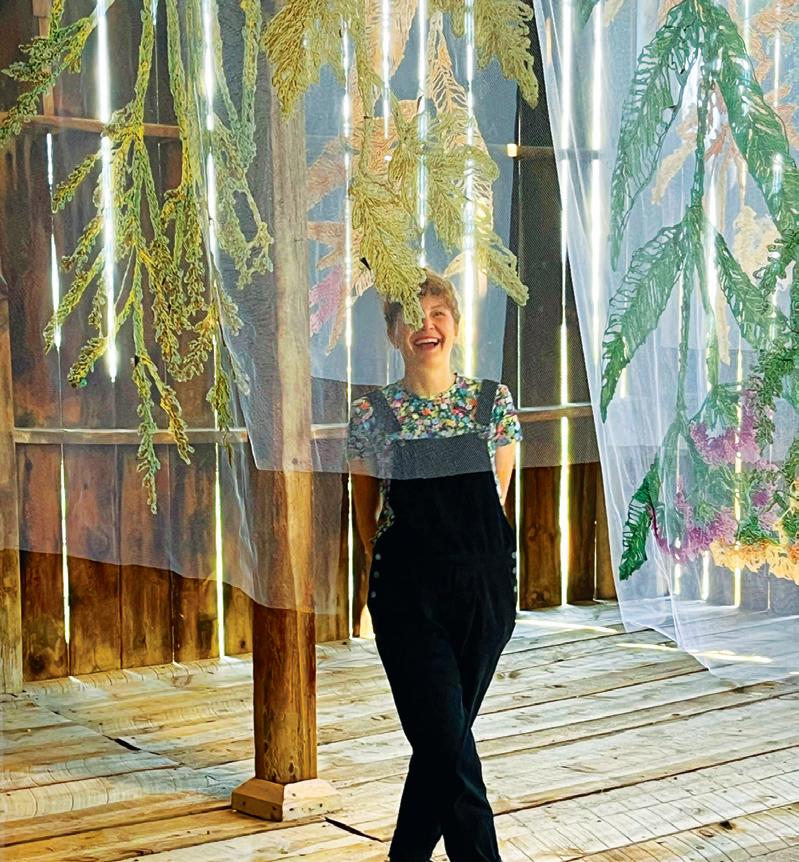
More than 15 artists pair with local farmers in agriCULTURE: Art
Inspired by the Land
The new multidisciplinary exhibition from the Longmont Museum and BMoCA explores the relationship between the land, the people who tend it and the communities who rely on it. Check out a feature on the exhibition in the 2023 Longmont Insider, included with this edition. See listing for details
Get in, losers — we’re going to a Destination Reading! Join Philly-based author Nick Gregorio to celebrate the release of his new Trident Press novel Launch Me to the Stars, I’m Finished Here at Boulder’s Trident Booksellers & Cafe. The night includes additional readings from Claire Hopple, Kevin Sampsell, Kathy Fish and Hilary Leftwich

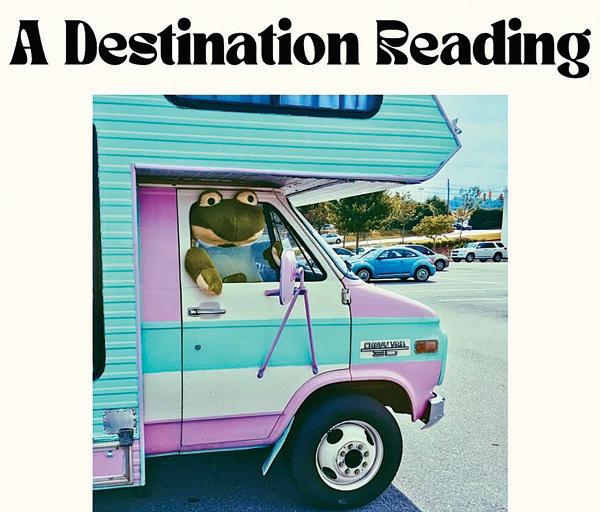
See listing for details
DARCIE SHIVELY: REPLY HAZY, TRY AGAIN.
The New Local Annex, 713 Pearl St., Boulder. 10 a.m.-noon Tuesdays and Thursdays through Aug. 27.
agriCULTURE: ART INSPIRED BY THE LAND BMoCA, 1750 13th St., Boulder; and The Longmont Museum, 400 Quail Road. Through Oct. 1 (BMoCA) and Jan. 7 (Longmont Museum). $2 / $8
BW Pick of the Week
VIEWS FROM ATOP MY BEDPAN: LIVING SEVEN DECADES THROUGH THE HEALTHCARE INDUSTRIAL COMPLEX BY ALAN O’HASHI.
6:30 p.m. Thursday, Aug. 24, Boulder Book Store, 1107 Pearl St. $5
TRIDENT PRESS BOOK
RELEASE: NICK GREGORIO W/ CLAIRE HOPPLE, KEVIN SAMPSELL, KATHY FISH AND HILARY LEFTWICH
6-8 p.m. Saturday, Aug. 26, Trident Booksellers & Cafe, 940 Pearl St., Boulder. Free BW Pick of the Week
ABSTRACT COLORS + FORM R Gallery + Wine Bar, 2027 Broadway, Boulder. Through September 10. Free
DESERT RIDER: DREAMING IN MOTION Denver Museum of Art, 100 W. 14th Ave. Pkwy. Through Sept. 24. $15
NO BOUNDARIES: WOMEN TRANSFORMING THE WORLD. Jerry Crail Earth Science & Map Library, 2200 Colorado Ave., Boulder. Through May 2024. Free
DESIGNING TRANSFORMATIVE EXPERIENCES BY BRAD
MCLAIN 6:30 p.m. Tuesday, Aug. 29, Boulder Book Store, 1107 Pearl St. $5
MYTHBUSTING THE GREAT OUTDOORS BY JAMIE
SIEBRASE 6:30 p.m. Wednesday, Aug. 30, Boulder Book Store, 1107 Pearl St. $5
10TH MOUNTAIN DIVISION AT CAMP HALE BY FLINT
WHITLOCK. 6:30 p.m. Thursday, Aug. 31, Boulder Book Store, 1107 Pearl St. $5
ARIES (MARCH 21-APRIL 19): None of the books I’ve written have appeared on the New York Times best-seller list. Even if my future books do well, I will never catch up with Aries writer James Patterson, who has had 260 books on the prestigious list. My sales will never rival his, either. He has earned over $800 million from the 425 million copies his readers have bought. While I don’t expect you Rams to ever boost your income to Patterson’s level, either, I suspect the next nine months will bring you unprecedented opportunities to improve your financial situation. For best results, edge your way toward doing more of what you love to do.
TAURUS (APRIL 20-MAY 20): Addressing a lover, D. H. Lawrence said that “having you near me” meant that he would “never cease to be filled with newness.” That is a sensational compliment! I wish all of us could have such an influence in our lives: a prod that helps arouse endless novelty. Here’s the good news, Taurus: I suspect you may soon be blessed with a lively source of such stimulation, at least temporarily. Are you ready and eager to welcome an influx of freshness?
GEMINI (MAY 21-JUNE 20): Humans have been drinking beer for at least 13,000 years and eating bread for 14,500. We’ve enjoyed cheese for 7,500 years and popcorn for 6,500. Chances are good that at least some of these four are comfort foods for you. In the coming weeks, I suggest you get an ample share of them or any other delicious nourishments that make you feel well-grounded and deep-rooted. You need to give extra care to stabilizing your foundations. You have a mandate to cultivate security, stability, and constancy. Here’s your homework: Identify three things you can do to make you feel utterly at home in the world.
CANCER (JUNE 21-JULY 22): On Instagram, I posted a favorite quote from poet Muriel Rukeyser: “The world is made of stories, not atoms.” I added my own thought: “You are made of stories, too.” A reader didn’t like this meme. He said it was “a nightmare for us anti-social people.” I asked him why. He said, “Because stories only happen in a social setting. To tell or hear a story is to be in a social interaction. If you’re not inclined towards such activities, it’s oppressive.” Here’s how I replied: “That’s not true for me. Many of my stories happen while I’m alone with my inner world. My nightly dreams are some of my favorite stories.” Anyway, Cancerian, I’m offering this exchange to you now because you are in a story-rich phase of your life. The tales coming your way, whether they occur in social settings or in the privacy of your own fantasies, will be extra interesting, educational, and motivational. Gather them in with gusto! Celebrate them!
LEO (JULY 23-AUG. 22): Author A. Conan Doyle said, “It has long been my axiom that the little things are infinitely the most important.” Spiritual teacher John Zabat-Zinn muses, “The little things? The little moments? They aren’t little.” Here’s author Robert Brault’s advice: “Enjoy the little things, for one day you may look back and realize they were the big things.” Ancient Chinese sage Lao-Tzu provides a further nuance: “To know you have enough is to be rich.” Let’s add one more clue, from author Alice Walker: “I try to teach my heart to want nothing it can’t have.”
VIRGO (AUG. 23-SEPT. 22): “I don’t believe that in order to be interesting or meaningful, a relationship has to work out—in fiction or in real life.” So says Virgo novelist Elizabeth Curtis Sittenfeld, and I agree. Just because a romantic bond didn’t last forever doesn’t mean it was a waste of energy. An intimate connection you once enjoyed but then broke off might have taught you lessons that are crucial to your destiny. In accordance with astrological omens, I invite you to acknowledge and celebrate these past experiences of togetherness. Interpret them not as failures but as gifts.
LIBRA (SEPT. 23-OCT. 22): The amount of rubbish produced by the modern world is staggering: over 2 billion tons per year. To get a sense of how much that is, imagine a convoy of fully loaded garbage trucks circling the earth 24 times. You and I can diminish our contributions to this mess, though we must overcome the temptation to think our personal efforts will be futile. Can we really help save the world by buying secondhand goods, shopping at farmer’s markets, and curbing our use of paper? Maybe a little. And here’s the bonus: We enhance our mental health by reducing the waste we engender. Doing so gives us a more graceful and congenial relationship with life. The coming weeks will be an excellent time to meditate and act on this beautiful truth.
SCORPIO (OCT. 23-NOV. 21): I hope that in the coming weeks, you will wash more dishes, do more laundry, and scrub more floors than you ever have before. Clean the bathrooms with extra fervor, too. Scour the oven and refrigerator. Make your bed with extreme precision. Got all that, Scorpio? JUST KIDDING! Everything I just said was a lie. Now here’s my authentic message: Avoid grunt work. Be as loose and playful and spontaneous as you have ever been. Seek record-breaking levels of fun and amusement. Experiment with the high arts of brilliant joy and profound pleasure.
SAGITTARIUS (NOV. 22-DEC. 21): Dear Sagittarius the Archer: To be successful in the coming weeks, you don’t have to hit the exact center of the bull’s-eye every time — or even anytime. Merely shooting your arrows so they land somewhere inside the fourth or third concentric rings will be a very positive development. Same is true if you are engaged in a situation with metaphorical resemblances to a game of horseshoes. Even if you don’t throw any ringers at all, just getting close could be enough to win the match. This is one time in your life when perfection isn’t necessary to win.
CAPRICORN (DEC. 22-JAN. 19): I suspect you are about to escape the stuffy labyrinth. There may be a short adjustment period, but soon you will be running half-wild in a liberated zone where you won’t have to dilute and censor yourself. I am not implying that your exile in the enclosed space was purely oppressive. Not at all. You learned some cool magic in there, and it will serve you well in your expansive new setting. Here’s your homework assignment: Identify three ways you will take advantage of your additional freedom.
AQUARIUS (JAN. 20-FEB. 18): Though my mother is a practical, sensible person with few mystical propensities, she sometimes talks about a supernatural vision she had. Her mother, my grandmother, had been disabled by a massive stroke. It left her barely able to do more than laugh and move her left arm. But months later, on the morning after grandma died, her spirit showed up in a pink ballerina dress doing ecstatic pirouettes next to my mother’s bed. My mom saw it as a communication about how joyful she was to be free of her wounded body. I mention this gift of grace because I suspect you will have at least one comparable experience in the coming weeks. Be alert for messages from your departed ancestors.
PISCES (FEB. 19-MARCH 20): “Those who know the truth are not equal to those who love it,” said the ancient Chinese sage Confucius. Amen! Seeking to understand reality with cold, unfeeling rationality is at best boring and at worst destructive. I go so far as to say that it’s impossible to deeply comprehend anything or anyone unless we love them. Really! I’m not exaggerating or being poetical. In my philosophy, our quest to be awake and see truly requires us to summon an abundance of affectionate attention. I nominate you to be the champion practitioner of this approach to intelligence, Pisces. It’s your birthright! And I hope you turn it up full blast in the coming weeks.
DEAR READERS: I’m off this week, so please enjoy this evergreen column from February 2011. If you’re wondering whether I’ve gotten any nicer over the past 12 years, this column is proof that I’ve gotten nicer. Way nicer. – Dan

DEAR DAN: I’m a 32-year-old female. Second marriage, two kids: one kid with my ex and one with the man I cheated on my ex with (my current husband). A year ago, I found my “first love” on a social network. I’d been looking for him off and on for more than 16 years. This person was a jerk who left me for one of my friends back in high school. But he was and still is the love of my life. He is not married, has never been married, and has no children. We began an affair about seven months after finding each other. My second husband, of three years, stopped having sex with me after I became pregnant, and this continued after our child was born. We tried counseling. It didn’t work. I also have a pretty bad track record and have cheated on every man I’ve ever been with, except for my first love. My first love is the worst person in the world for me. Yet I’m in love with him. He wants me to leave my whitecollar husband for him, a very bluecollar guy. I live in a nice home in the suburbs; my first love lives in a small apartment in the city. Five months after we began having sex with each other, my current husband found out. Instead of leaving me, he has turned into a different man: extremely loving and attentive. He says this experience has made him realize how much he loves me and that he doesn’t want to lose me.
I want to do what is best for my kids — and that would be staying right where I am. But I feel my only chance for “true” love, if there is such a thing, is passing me by. Dan, pull out all the stops on this one, as you famously do, and please tell me what to do.
DEAR SCIL: You say you’ve cheated on every man you’ve ever been with, with the exception of your “first love,” and you regard that as a sign your first love was your true love. You two broke up when you were 15 years old. If you’d been with him a little longer another week, maybe two — you would’ve cheated on him like you’ve cheated on everybody else.
If you leave your current husband and break up your first child’s second home and your second child’s first home and go back to your first love, it won’t be long before you get around to cheating on the love of your life, too. Because you’re a cheater. You’re a habitual, serial cheater. You’re precisely the kind of person who shouldn’t make monogamous commitments. Or get married. Or have children.
So, what should you do? Stay? Go?
Frankly, SCIL, I don’t give a fuck. Stay or go, it’s not going to make a fuck of a lot of difference. Your personal life is a mess, SCIL, and it always will be. Because, you see, wherever you go, there you are
 BY MICHAEL J. CASEY
BY MICHAEL J. CASEY

Pica (Toby Smith) is an Oakland college student taking Polaroids in a photography class devoted to 35 mm. “I came here to learn how to express myself,” she tells the teacher (Salim Akil). “You gotta have a 35 mm camera to be expressive nowadays?”

He’s interested in theory, but Pica is trying to capture the faces of young Black men. They’re “an endangered species,” she tells Tobi (April Barnett). Between the crack epidemic raging around them, and a serial killer at large, indeed they are.

But photos only accomplish so much. So Pica builds handcrafted totems, gravestone-like sculptures for the fallen, in a vacant unkempt patch of grass in the middle of her neighborhood. They’re offerings from the heart. So it is with 1998’s Drylongso, the lone feature from multidisciplinary artist Cauleen Smith. The title, a Gullah Geechee word meaning “everyday folk,” is exactly what Pica and Smith are after — Pica with the residents of her neighborhood, Smith with Pica and Tobi, two young women trying to find their place in the world.
But many critics and audiences didn’t necessarily see the movie. As Smith explains in an interview with scholar Michael B. Gillespie on Criterion’s newly released disc, those viewers in ’98 focused more on the movie as a social document rather than a piece of artistic expression. It turned Smith off narrative work, and she hasn’t made a feature since. She’s directed many fascinating shorts, including the seven featured on Criterion’s set. All examples of a cinematic career that could have been.


Smith is far from the only filmmaker backed into a creative corner. Criterion’s other newly released set, The Ranown
Westerns, shows that the laser focus of success often obscures the multiplicity of artists.
Released in a prolific fever of four years, 1957-’60, the Ranown cycle (The Tall T, Decision at Sundown, Buchanan Rides Alone, Ride Lonesome and Comanche Station) are some of the best entries into the Western genre: spare, sincere, tough.
Randolph Scott stars in all five, with Budd Boetticher directing with an aesthetic sensibility that keeps them from being simplistic or forgettable.
Criterion’s set includes stunning restorations of all five movies and a handful of documentaries about Boetticher. In all but one, Boetticher gets frustrated with the interviewer trying to paint him as a cowboy, the movies as a form of autobiography.
Boetticher directed over 30 features in a career spanning four decades, and yet it will always be these five movies made in four years that land him in the history books. Smith directed only one. The significance of their films cannot be denied, for reasons they intended and a few they didn’t. Artists don’t necessarily get to choose what history remembers them for, but, in the end, it is the work in all its dimensions that lasts.
FROM THE BOTTOM OF OUR HEART, WE WANT TO THANK OUR COMMUNITY FOR SUPPORTING LOCAL BUSINESSES!
 BY JOHN LEHNDORFF
BY JOHN LEHNDORFF
If you’re convinced absolutely nothing good came out of the COVID pandemic, talk to Daniel and Talia Haykin. They may change your outlook and help you discover you really like hard cider.
Like so many local food companies, Haykin Family Cider, founded by the couple in Aurora in 2018, faced potential extinction in 2020.

“When the pandemic happened, most of our ciders were being served at local fine-dining restaurants. Suddenly, they all had to close,” says Daniel. “Our tasting room was closed and sales were low at stores. To survive, we decided to bring our ciders directly to consumers.”
Haykin Family Cider focused on its online cider club and retailing, and bringing ciders to farmers markets, including Boulder’s this year.
“The experience changed our DNA as a company,” Daniel says. “We decided that we would never again miss an opportunity to go directly to the consumer and tell our story without a middleman.”
The benefits of personal contact are abundantly clear when you stand at the Haykin Family Cider booth at the Boulder Farmers Market on any given Saturday. Curious folks approach Daniel and Talia or one of their helpers, who clear up myths as they share samples of sparkling ciders, each made from a single Colorado apple variety, ranging from their refreshing, crisp McIntosh cider to the complex Yarlington Mill cider.
For instance, ciders don’t have to be sweet and flavored like the popular Angry Orchard’s products. They can be dry and barely fruit. Market samplers experience the revelation that good ciders are much more like wine than beer and made to be enjoyed with food — whether it’s a hot dog or coq au vin Tasting reveals exactly why Haykin ciders have won so many awards, including medals at the cider Oscars: the Great Lakes International Cider and Perry Competition.
For Daniel, a financial advisor who has worked on Wall Street for Lehman Brothers, being at the farmers’ markets
I love the smell of a new bakery first thing in the morning. The aroma of bolillo sandwich rolls emerging golden from the oven and dulce de leche empanadas cooling in a rack greeted me when I walked into the recently opened Panaderia Tradicional Y Neveria at 1312 Centaur Village Drive in Lafayette.
Open 8 a.m.-8 p.m. near Centaurus High School, the bakery produces classic Mexican cakes, conchas, pan dulce and galletas, plus cream cheese and jalapeño filled breads. Ice cream by the scoop and in sundaes are available along with traditional savory snacks, like two versions of elotes (Mexican street corn), and chilindrinas, a delightful combination of pickled pork skin, cabbage, tomatoes, avocado, hot sauce, crema and lime.
The local panaderia choices also include Boulder’s Panaderia Sabor a Mexico, 2839 28th St., Lafayette’s Sweet Bites Panaderia, 100 E. South Boulder Road, and Panaderia Guanajuato, 1630 Main St. in Longmont.
and other events and working at the cidery’s tasting room are good investments.
“It really changes things a lot when you show up in person,” he says.
The Haykins may be new to the market but not to Boulder. Their inspiration started with a devotion to heirloom apples, which the city has a long history with.
“[Making cider] was a subversive way for us to advocate on behalf of heirloom fruit,” Daniel explains. “Nobody really cares about an apple if all you’re doing is smearing peanut butter on it. If you want to highlight heirloom apples and make people care about saving them, you have to make it into something that captures their attention.”
Prior to Prohibition, Boulder County had a thriving apple industry largely devoted to hard cider. But coupled with disease and drought, Boulder’s apple orchards were wiped out in the ’20s. But many trees, abandoned in alleys and fields, survived to tell a story of Boulder’s past.
Today, Boulder Apple Tree Project is dedicated to finding and saving heirloom varieties of apple trees growing in fields, alleys and on abandoned orchards. So far, the organization has tagged hundreds of historic trees. The project also assists Community Fruit Rescue (a Boulder organization dedicated to harvesting local trees to stock food banks), keeps bears safe by removing fruity temptations where people live, and helps businesses like the Haykin’s produce ciders.
“We’ve been involved with the Boulder Apple Tree Project for years,” Daniel says. “When I heard what they were doing I wanted to help in any way possible.”
Daniel notes that Colorado’s cider movement is growing, with more than two dozen craft cideries producing artisan beverages ranging from Teal Cider in Dolores to Big B’s Delicious Orchards in Hotchkiss.
The Boulder area is home to several notable cideries including BOCO Cider in Boulder, Lafayette’s Acreage, the home of Stem Ciders, St. Vrain Cidery in Longmont and Wild Cider in Firestone.
The cider boom comes in the wake of the successes at Colorado breweries, wineries and distilleries.
“The consumer in Colorado is very open-minded,” Daniel says. “There’s a real ethos here of appreciating small producers and their craft products.”




● We offer a heartfelt salute to Bert Steele, the beloved co-owner of the Niwot Market, who died on Aug. 7. Niwot’s unofficial “mayor” and one of the last of the old-school grocers, Steele’s life will be celebrated from 2-9 p.m. Aug. 26 at the Niwot Tavern at Bluegrass for Bert, a free concert featuring five bands.
● Takoyaki, okonomiyaki, yakisoba, Japanese sweets and traditional Japanese kids’ games are on the menu at Osaka’s End of Summer Festival 3-7 p.m. Aug. 27 at 2460 Canyon Blvd., Boulder.

● Boulder’s Jacob Springs Farm hosts a Slow Food farm dinner Aug. 26 featuring Gambian-born chef Modou Jaiteh. Proceeds benefit local BIPOC farmers. Tickets: bit.ly/JacobsSpringLateSummer
● Born in 1923, The Sink is being celebrated with a new exhibit at the Museum of Boulder. Opening Aug. 27, The Sink: The Rest [aurant ] is History, spotlights the food, beer, culture, music and art connected to the celebrated CU-adjacent eatery. If you visit on Sundays, you can view the Sink’s new 100th anniversary documentary.





“Everybody dies. There’s no avoiding it and I do not believe for one second that butter is the cause of anyone’s death. Overeating may be, but not butter, please. I just feel bad for people who make that mistake.”
 Nora Ephron
Nora Ephron
Don’t miss Boulder Weekly’s comprehensive guide (with map) to Boulder County’s roadside farm stands at: bit.ly/2023FarmStands









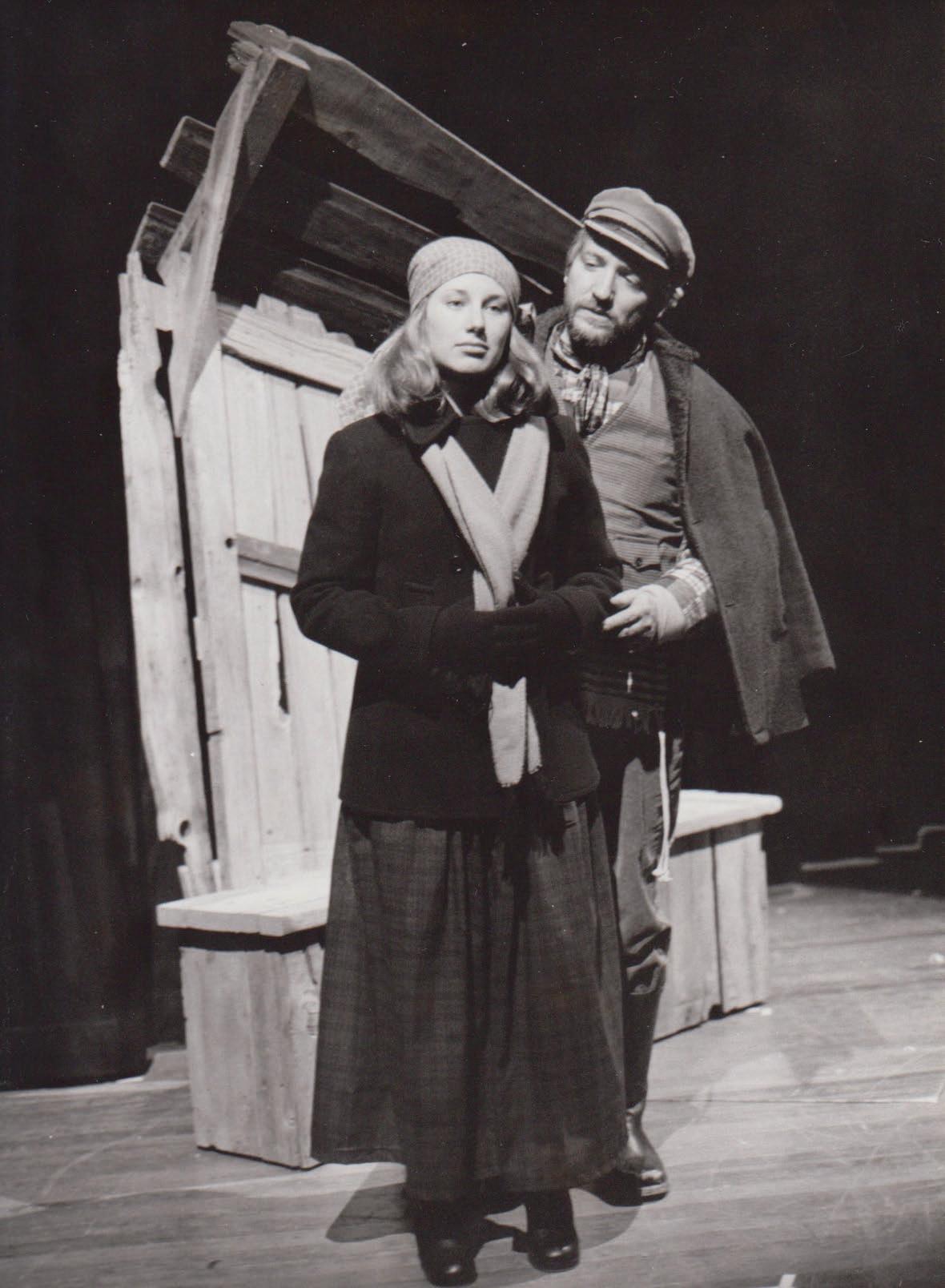






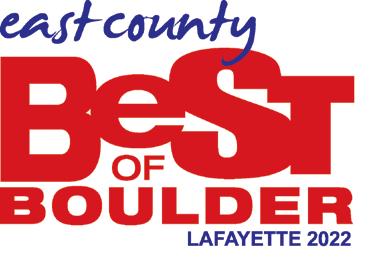


When Gitanjali Shrestha moved from Pokhara, Nepal, to Longmont in 2007, she wasn’t quite sure what she was going to do. Up until then, she’d been working in hospitality, most recently as the public relations manager at the Shangri-La Village, one of Pokhara’s most prestigious five-star resorts.
Gitanjali grew up cooking. “I had a passion. I’d take hours in the kitchen, as much to impress myself as to impress others,” she says. Even as her career took her along the front-of-house and client relations course, she still kept an interest in cooking: “At Shangri-La, I’d walk into the kitchen and get the cooks to teach me the dishes.”
When Gitanjali arrived in America, one of her first impulses was to open a restaurant. “I didn’t have a lot of money when I moved here, but I had a lot of courage,” she says, adding that she almost opened a spot in Louisville in 2008.
Instead, she started working as a certified nursing assistant and spent four years doing end-of-life care before

opening her own home-care company, Helping Angels, in 2011. “It was hard, but I’m so glad I learned,” she says. Helping Angels is still up and running.
So for Gitanjali, the 2022 opening of Indian Bites in one of Longmont’s many strip malls had been a long time coming.

She launched the eatery with her husband, Bhaskar Shrestha, who had moved stateside from Kathmandu in January 2021. The two had met a few years earlier at a party at Bhaskar’s restaurant Godhuli, a cozy spot in the Nepalese capital Bhaskar had owned and operated for the better part of a decade. “The food was so good, it almost made me cry,” says Gitanjali.
Indian Bites is a family affair. Gitanjali handles the dining room with grace while Bhaskar churns out scratch-made Indian and Nepalese classics.
Gitanjali’s mom, Ranjana, and her brother, Sudhir, are also common features both upfront and in the kitchen.


“It took years, but here we are,” says Gitanjali, beaming. “As an immigrant, it takes time to learn the system.” Before opening Indian Bites, Gitanjali and Bhaskar were serving similar dishes from the Hurry 4 Curry food truck, which is still in operation under the direction of her brother, Biswant.
Much of the menu is made up of the kind of stuff Bhaskar used to serve at Godhuli, with a few alterations and concessions being added for Western palates. “Americans and Europeans like the creamy stuff,” says Gitanjali. “In traditional Nepalese cooking there’s not a lot of cream.”


The menu is broken down into sections, which include masala, korma, curry, saag, vindaloo, jalfrezi, madras and kahari, all of which are available with the choice of chicken, shrimp, lamb and fish. The signature entrees

also feature a festive interpretation of butter chicken. Don’t leave without getting the paneer pakora, a dish of brightly-colored cheese curds, largely distinguishable from their Wisconsin cousins by the presence of housemade mint chutney served alongside instead of ketchup or ranch.
“We make our food with love and that makes a huge difference,” says Gitanjali. “I am literally one mile from my home. Longmont is home. I love this community.”
Gitanjali says Indian Bites came from a shared fantasy between her and Bhaskar, one that was discussed throughout their courtship. “This is almost like a dream come true, to find a soulmate,” she says.
It also doesn’t hurt that the sauces are all made fresh daily with spice blends that Bhaskar has been honing throughout the course of his life. The smell of freshly ground cumin and coriander seed being added to the simmering pots can be picked up from down the block. The house-made chai is also a must, arriving fresh from a cauldron Gitanjali prepares each morning.
Dishes arrive in heaping portions and are most sensibly eaten with a helping of garlic naan. “We are not stingy,” Gitanjali says with a smile. “Our customers deserve the best.”
Gitanjali says that while she’s happy to see Indian Bites take off, she has no intention of stopping here: “We are really interested in Estes Park.”













 BY COLIN WRENN
BY COLIN WRENN
There’s a plot of land in Northern Colorado, somewhere between Berthoud, Loveland and Johnstown, where the Olander family has been farming since 1926. For five generations, they’ve grown grains, including barley, wheat, rye and non-GMO corn, under the name Olander Farm.
And just last week, the family business launched its first line of single malt whiskey, with a bit of help from Boulder’s Vapor Distillery.
Todd Olander grew up on the farm, learning the ins and outs from an early age. “In high school, I had decided I was never going to come back to the farm,” he says. He attended Colorado State University where he got a degree in construction management.
But it didn’t take long for the prodigal son to return. “As soon as I got done with college, I went straight back to the farm,” Olander says.
As luck would have it, his time in Fort Collins proved highly influential for the future of Olander Farm. “I watched the growth of Odell and New Belgium,” he says, adding that it didn’t take long for him to become infatuated with Colorado’s growing brewing culture.
So in 2016, he and his father, Steve, launched Root Shoot Malting, with the expressed intent of providing high-quality grain and malt to the many local breweries that were looking for a superior product. “We took a lot of tours of breweries and asked them where they got their grain and there really wasn’t a Colorado option,” says Olander.
Since its debut, the business has boomed. “Five years ago we had the opportunity to malt 10 tons
a week, now we’re up to 30,” Olander says, adding that Root Shoot distributes to between 125 and 150 breweries, as well as 15 distilleries, almost all of which are in Colorado. Root Shoot grain can be found in spirits from Breckenridge Distillery, The Block, Distillery 291, The Family Jones and Vapor Distillery, home of Boulder Spirits. “It’s more influential when you try to keep it local,” Olander says.
While Root Shoot is relatively new, Olander Farm has been providing barley to Coors since the 1980s. “That’s the most important piece of the puzzle, having good grain,” Olander says.

For the first time, the farm decided to use that grain to produce Root Shoot Spirits’ first single malt whiskey. “What better way to express our malting plant and our farm than a single malt whiskey,” Olander says. The five-year aged, bottled-in-bond release was produced at Vapor Distillery, with the initial run limited to 10 barrels, or 2,400 bottles. It’s currently being distributed across the Front Range.
While Vapor started out as one of Root Shoot’s clients, it quickly became clear that the two could expand their partnership: Vapor provides equipment and licensing, managing the actual distilling and bottling, while Olander supplies the recipe and grain. “Pretty plain and simple,” says the distillery’s brand manager Ryan Negley.
“You can’t get any more Colorado than this,” says Olander. “Distilled just miles from Olander Farms, where its raw materials were grown, Root Shoot Whiskey is true Colorado whiskey, from our grain to your glass.”

Going forward, Root Shoot is planning to do a unique annual release, with next year’s production set to be three times larger than this round. “With single malt, you’re not relying on new grain, instead you’re working with the malt characteristics. Every year is going to be a different recipe for the malt,” says Olander.
“The Root Shoot whiskey is good. There’s no denying it,” says Negley. “It started with great farming, which they’ve been doing forever. The malting equipment they use is top notch, world class. Then it gets to us, and our still was built for barley. Add in the magic of Colorado aging and voila.”
As self-described stewards of the land, the Olanders take regenerative agriculture seriously. In December of 2022, Olander Farms and Root Shoot Malting together finalized a conservation easement with Colorado Open Lands, an agreement that permanently limits the use of their 112 acres, enduring the continued pace, quality and permanence of protected agriculture in the region. Good ethics aside, the whiskey is a great sipper. “We’re trying to find sustainability within agriculture on our own terms,” says Olander.








Many who suffer from chronic HIV use cannabis to control their symptoms. Anecdotally, patients say it helps reduce nausea, eases anxiety, lifts depression and reduces nerve pain, tingling, numbness, weight loss, headaches, tremors, constipation and general lethargy.

Research from 2005, published in the Journal of Pain and Symptom Management, backs that up. Out of 523 patients surveyed, 143 (or 27%) used cannabis to treat their HIV symptoms. Researchers found that among those cannabis users, the most notable improvements reported were an increased appetite and reduced pain.
“The positive responses to symptom control recorded in this study,” the paper concludes, “suggest that it is highly probable that cannabinoid medications have a medicinal role in this condition for a number of reasons.”
However, cannabinoids have immunomodulating effects on the body. A review of public research from 2021 finds that it affects T-cells, B-cells and monocytes, and causes an increase in anti-inflammatory cytokines. Using cannabis to treat a disease that depletes one’s immune cell count could be coun-

ter-productive to treating the infection even if it helps treat the symptoms.
That’s why the National Institute on Drug Abuse (NIDA) recently awarded researchers from Weill Cornell University an $11.2 million grant to study the effects of cannabis use on HIVinfected brain tissue. While anecdotal evidence suggests that cannabis helps HIV patients, there’s no data yet on how this drug directly affects their brain tissue.
“We know that the virus may cause changes within the brain, but it’s not clear yet how the use of cannabis might interact with the infection,” says Lishomwa Ndhlovu, Weill Cornell professor of immunology. “This support from NIDA will allow us to collect the data we need to explore this relationship.”
This question is long-standing and extends beyond HIV symptom treatment. NIDA reports that somewhere between 25% to 40% of cancer patients also use cannabis to treat the symptoms of either the disease itself or chemotherapy treatment. And like HIV, both cancer and chemotherapy can suppress and weaken a patient’s immune system.
Raising even more concerns, other NIDA-funded research published in the International Journal of Molecular Sciences in 2022 suggests that under certain circumstances, cannabis use can actually stimulate cancer growth. Of course, there is also research to support cannabis as a useful, natural, nonaddictive medication to help cancer patients ease many of the same symptoms HIV patients use it for. But while much research focuses on the relationship between cannabis use and cancer — both supporting and decrying the idea — when it comes to the relationship between cannabis use and HIV, there is very little beyond the anecdotal. That’s a problem that Ndhlovu and his team of researchers at Weill Cornell aim to resolve.
“The goal here is to use really advanced single-cell technologies that are now made available to us to really get into the impact at the single-cell level,” Ndhlovu says. “[That will] give us a much better mapping of what may be going on.”
NIDA’s grant toward Ndhlovu’s research is an extension of its Single Cell Opioid Responses in the Context of HIV (SCORCH) program. Initially, the program was focused solely on how opioids may modify the impact of HIV on the brain at a cellular level, but it has since branched out to include all “addictive substances,” lumping cannabis into that group (Weed Between the Lines, “Shifting perspectives,” June 22, 2023).
Ndhlovu notes that this isn’t a clinical trial. In other words, they aren’t dealing with individuals living with HIV. They’ll be using autopsy specimens and hightech single-cell technologies to gather data on how cannabinoids affect HIVinfected human brain tissue. The results will eventually be aggregated and made available for other researchers to expand upon.
“Because such a huge amount of data will be generated,” Ndhlovu says, “it may not be possible for one individual to analyze all of that.”
It will likely take years, Ndhlovu says. And he doesn’t expect to walk away with an end-all answer as to whether HIV patients should use cannabis to treat their symptoms or not. But if all goes to plan, they’ll end up providing a massive bank of data that could move us closer to understanding that.
















